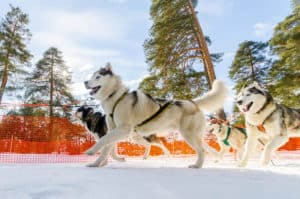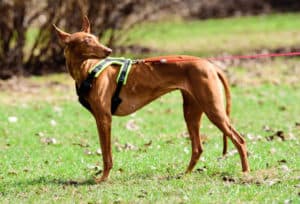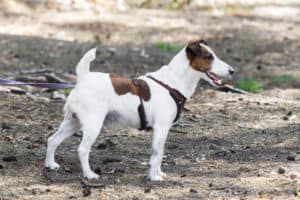There are many different types of harnesses available for your dog. Whether you have a miniature dog or a large dog, there is a harness available to suit your dog and your needs.
When it comes to choosing a harness for your dog, you need to make sure that the fitting is correct. Most importantly, you need to make sure that it’s not going to cause any health issues down the line. An incorrect harness can cause a lot of physical problems for your dog.
You may wonder why a harness is needed at all. After all, many years ago, dogs were walked with a lead clipped onto their collars. Why can’t we just clip the lead onto the collar?
Collar or Harness For My Dog?
Science is now showing that dog’s necks are not as strong as we once thought. Their necks are actually as sensitive as our necks and can be damaged quite easily.
PetMD states that repeated stress to the neck can lead to long-term medical issues such as damaging the thyroid glands and the tissue around the neck area. PetMD recommends a chest harness rather than using the collar for lead walks.
Which Harness is Good For My Dog?

Not all harnesses are created equal, and not all harness designs are suitable for your dog. Just because a harness is a popular brand that does not mean that it is a good harness for your dog.
Rather than recommend a specific brand of harness, as some brands may not be available in every location, I think it’s a better option to know what to look for in a harness.
There are some things that you need to look out for in a harness. A harness may say that it stops pulling, but that doesn’t mean that it actually will, and it may not be good for your dog’s health.
Some harnesses which claim to stop pulling are restrictive harnesses that hinder the movement of the dog’s forelegs and shoulders. They can also tighten around the dog causing pain or discomfort. The dog doesn’t actually learn not to pull on the lead, it learns that this tool causes pain or discomfort.

Some Basics To Look for in a Harness for Your Dog

There are some basics that you should look for in a harness, no matter the size of your dog, or what you need your harness to do.
- Should be a good fit:
- – not too tight, you should be able to fit two fingers between the harness and the dog’s fur.
- – not too loose, your dog should not be able to wriggle out of the harness.
- The harness should not restrict your dog’s shoulder and front leg movement. Restricted shoulder and front leg movement can cause long-term damage to your dog.
- A Y-shaped harness will allow freedom of movement in the shoulder and front leg.
- To reduce pulling, you need a 2-point harness, not a harness with just one lead clip on the back. A 2-point harness has a lead clip on the front of the harness (the dog’s chest area) and on the back of the harness. This will aid you while you train your dog to lose lead walk.
Y Shaped Harness For Your Dog

A good design for a harness is the Y-shaped harness. These go around the neck down the chest and around the ribs. They form a Y shape when viewed from the front of the dog. From the side view, the harness should not be too close to the dog’s elbow.
These types of harness, when correctly fitted, don’t put any pressure on the forelegs, neck, or back of the dog when walking. Remember, the harness should fit tightly to the body, but you should be able to slide two fingers between the harness and the dog. If you can’t, then it is too tight.
Any looser and the dog risks being able to wriggle out of the harness. Not something that you want to happen on a walk!
It is a good idea to take your dog and get them properly fitted for their harness. If you have a puppy, you should check the harness regularly to make sure that it hasn’t outgrown the harness.
Restriction of Shoulder and Front Leg Movement of Your Dog

Restriction of the front leg and shoulder movement is a huge deal. A lot of harnesses don’t seem to consider this in their design.
There is now a body of scientific evidence showing that harnesses that restrict the natural movement of the shoulder and front leg can produce long-term damage to the dog. With further studies underway to see if the design of some harnesses is causing orthopedic issues in dogs.
You should avoid any harnesses that have a strap that goes across the chest and over the shoulder joints. An easy way to spot this type of harness is that from the front view of the dog, they are a T shape. These restrict the foreleg motion and prevent the dog’s natural walking gait. Prolonged use can alter the dog’s natural stride even when they are not wearing the harness.

I hope this article has given you an idea of what you should look for in a harness and what you should avoid.
Before you go, you may find these articles helpful:

Leave a Reply